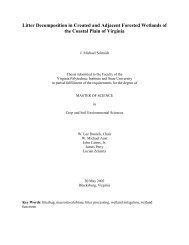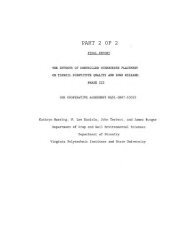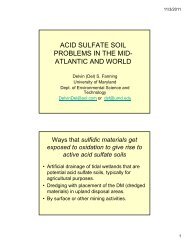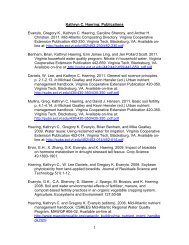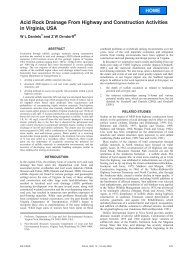Remediation of PAH-Contaminated Soils and Sediments: A ...
Remediation of PAH-Contaminated Soils and Sediments: A ...
Remediation of PAH-Contaminated Soils and Sediments: A ...
Create successful ePaper yourself
Turn your PDF publications into a flip-book with our unique Google optimized e-Paper software.
Cometabolism is explained by three basic reasons (Alex<strong>and</strong>er, 1999):<br />
� Initial microbial enzymes are used to convert a substrate into an organic<br />
product which is not further transformed by other enzymes specific to that<br />
microorganism. No metabolic intermediates used for biosynthesis or<br />
energy production are produced in this scenario <strong>and</strong> accumulation occurs.<br />
� Initial substrate is transformed into enzyme inhibiting or growth<br />
suppressing organic products.<br />
� An additional substrate that is not available at the time <strong>of</strong> the reaction is<br />
needed by the microorganism to complete the degradation <strong>of</strong> both<br />
substrates.<br />
In the first part <strong>of</strong> the cometabolism degradation reaction, the following equation<br />
can be used to represent substrates (A, B, C, D) <strong>and</strong> enzymes (a, b, c, d):<br />
a b c<br />
A B C D →→→→ CO2 + energy + cell-carbon<br />
Enzyme “a” might have low substrate specificity <strong>and</strong> can act on A or on the<br />
product <strong>of</strong> A (or A’). The product <strong>of</strong> B (or B’) might differ in the same way that A<br />
<strong>and</strong> A’ differ, but enzyme “b” has higher substrate specificity <strong>and</strong> cannot degrade<br />
B’. So, B’ would accumulate as represented by the following equation:<br />
a<br />
A’ B’<br />
The substrate <strong>of</strong> these cometabolic reactions persists in the soil <strong>and</strong> is not<br />
mineralized into CO2, microbial energy <strong>and</strong> cell-carbon. In the case <strong>of</strong> <strong>PAH</strong>s, the<br />
product <strong>of</strong> naphthalene (A’) may continue to be degraded, but the product <strong>of</strong><br />
Benzo[a]pyrene (B’), or metabolite, may not be further degraded <strong>and</strong> accumulate<br />
in the soils. Though Benzo[a]pyrene may be degraded as mentioned earlier, the<br />
problem with this situation is that metabolites can be more carcinogenic than the<br />
initial substrate (Alex<strong>and</strong>er, 1999).<br />
Scientifically supported degradation <strong>of</strong> HMW <strong>PAH</strong>s in the presence <strong>of</strong> LMW<br />
<strong>PAH</strong>s is discussed or reviewed in the following literature:<br />
� Juhasz <strong>and</strong> Naidu (2000) reviewed several studies where the presence <strong>of</strong><br />
LMW <strong>PAH</strong>s enhanced the degradation <strong>of</strong> benzo[a]pyrene through cometabolism.<br />
31



